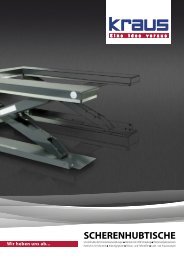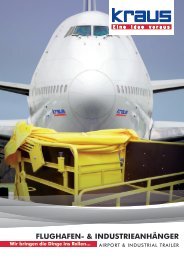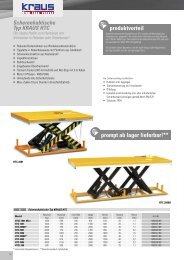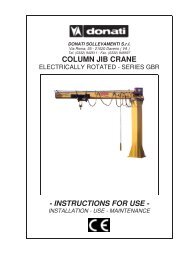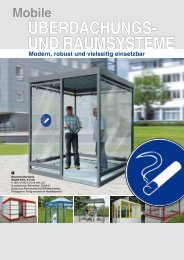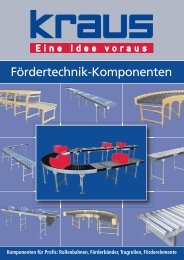JIB CRANES WITH AN ARTICULATED ARM MANUALLY ROTATED
JIB CRANES WITH AN ARTICULATED ARM MANUALLY ROTATED
JIB CRANES WITH AN ARTICULATED ARM MANUALLY ROTATED
Create successful ePaper yourself
Turn your PDF publications into a flip-book with our unique Google optimized e-Paper software.
DONATI SOLLEVAMENTI S.r.l. - Via Roma, 55 - 21020 Daverio (VA) - Tel. 0332 942611 - Fax. 0332 948597<br />
§ Dynamic test runs:<br />
• prepare adequate weights for the test runs with load equal to nominal lifting capacity x 1.1 and<br />
suitable equipment for the harnessing and lifting of the load.<br />
• harness the load, taking care to position the hook vertically to avoid skew rope falls.<br />
• slowly tension the sling so as not to cause tearing, if available do the test runs with load using the<br />
“slow” speed.<br />
• slowly lift the load and check that this happens with no difficulty and that there are no anomalous<br />
noises, clear deformations or sagging in the structure of the crane, in the support structures and/or<br />
the anchorings<br />
• repeat the test run at maximum speed, if available, doing the preceding checks<br />
• check the functionality of the “ascent and descent” limit switches, when installed, and/or any clutch<br />
device fitted.<br />
• check the functionality of the lifting brake, checking that the weight is braked in adequate time and<br />
that there is no skidding of the load, after releasing the button.<br />
• carry out the same checks also for the trolley travelling movements and rotation of the arm,<br />
checking the functionality of the limit switches, without bringing the load to the maximum height (lift<br />
it to a height of one metre from the ground).<br />
• operate first at slow speed, if available, and then at maximum speed<br />
• check the correct sliding of the trolley on the girder, and ascertain that there are no no anomalous<br />
noises, evident permanent deformations or anomalous sagging of the structure of the crane, of the<br />
support structure and/or the anchorings.<br />
• check the functioning of the “emergency stop” button which must stop and inhibit all the<br />
movements. Any function of the hoist and/or trolley must stop, in the shortest possible time and<br />
space, without showing anomalies,side skids, dangerous oscillations, etc. which threaten the<br />
stability.<br />
• check the braking spaces and stopping spaces during lifting travelling and rotation, checking the<br />
stability of the mass manoeuvred.<br />
The dynamic test run must be carried out in the most unfavourable load conditions,<br />
that is combining lifting and rotation.<br />
§ Static test runs:<br />
• use suitable masses for the test runs equal to: nominal lifting capacity x 1.25 and suitable<br />
equipment for slinging and lifting the load<br />
• put in the sling the load used for the dynamic test runs (nominal capacity x 1.1) taking care<br />
to position the hook on the vertical to avoid skew runs<br />
• tension the sling slowly to avoid tearing, if available carry out the test runs using the “slow”<br />
speed<br />
• lift the load and stop it in a suspended position at a height of 10cm<br />
• gradually apply weight on it until reaching an overload value equal to 25% of the nominal lifting<br />
capacity<br />
• leave the weight suspended for no less than 10 minutes.<br />
• check that the weight suspended (load + overload) does not yield (the lifting brake and the<br />
clutch device/load limiting switch, if installed, must not skid).<br />
• release the load and check that there are no evident deformations and/or sagging of the<br />
structures of the crane, the support structures and/or the anchorings.<br />
• During the static test run NO movement of the crane must be activated.<br />
• The testing of the jib crane must be repeated at the annual checks<br />
(see paragraph 6.3.2)<br />
• The results of the annual testing must be noted in the checks register (see chapter 8)<br />
included with this publication, when required.<br />
35



